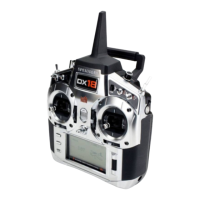34 SPEKTRUM DX18 • TRANSMITTER INSTRUCTION MANUAL
EN
SAIL Mixing
For each of these mixes, you can program each fl ight mode with
different mix values or at 0% if no mix is desired for that specifi c
fl ight mode. Programming values include independent control of
the direction and amount a slave surface moves in relationship
to the master surface.
Aileron to Rudder
The Aileron to Rudder mix is a commonly used for coordinated
turns. When active, as aileron is applied the rudder moves in
the same direction as the turn (right aileron input results in
right rudder output). If you assign the fl ight mode to a switch, a
Sub Switch option allows you to assign an additional switch to
activate up to 3 Aileron to Rudder mixes for that fl ight mode.
Aileron to Flap
The Aileron to Flap mix allows the entire trailing edge of the wing
(aileron and fl ap) to operate as ailerons. When the mix is active,
the fl aps move with the ailerons.
Elevator to Flap
Elevator to Flap mix creates additional lift, allowing a tighter turn.
The entire trailing edge of the wing (aileron and fl ap) operate
as fl aps (camber increase) when you apply elevator. An offset is
provided which is typically used for Snap Flaps. With Snap Flap,
no Elevator to Flap mix occurs until the offset value is reached.
Typically this offset is at 70% up elevator so that beyond 70%
the down fl ap mix comes in, providing additional lift for more
aggressive turning (for tight thermals or racing turns).
Flap to Elevator
Flap to Elevator mix prevents pitch up tendency that occurs
when you apply Crow or Butterfl y. This mix is typically used only
with the Camber System. The Flap to Elevator mix operates as
a curve, so that the elevator moves down the most during the
fi rst 20% of fl ap deployment, decreases over the next 40% then
remains the same from 60 to 100% of fl ap travel.
For sailplanes with ailerons/tips/fl aps, make sure an appropriate
Sailplane Type is selected so that tips appear in the transmitter
as RAIL and LAIL. Decrease or increase travel on the tip ailerons
by creating an AIL > RAIL mix.
AR9020 Receiver Specifi cations:
Weight: 0.42 oz (11.9 g)
Voltage Range: 3.5V-9.6V
Length: 1.61 in (41mm)
Width: 0.91 in (23mm)
Height: 0.79 in (20mm)
Range: Full
Number Of Channels: 9
Band: 2.4GHz
Model Type: Airplane/Heli/Sailplane
Telemetry: Yes
Features:
• 9-channel full range receiver
• Patented MultiLink™ receiver technology
• Includes one internal and two remote receiver
• An optional third remote receiver can also be used
(SPM9645)
• SmartSafe™ failsafe system
• QuickConnect™
• Flight Log and Telemetry compatible (optional)
• 2048 Resolution
• High-speed 11ms operation when used with
capable transmitters
Receiver Installation
For optimum RF link performance, mount the main receiver
and remote antennas in an orientation that allows for the best
possible signal reception when the aircraft is in all possible at-
titudes and positions. Where supplied with the transmitter, install
the primary receiver in your model. Put the primary receiver
in protective foam and install the receiver in the model using
rubber bands or hook-and-loop straps. Use thick double-sided
foam tape to install the primary receiver in electric airplanes or
helicopters.
Mount each remote receiver at least 2 inches (51mm) away
from the primary receiver, primary antenna and each other using
double-sided foam tape. Orient the antennas perpendicular
to each other; typically one vertical and one horizontal (see
manufacturer’s receiver installation instructions). This gives
tremendous improvements in path diversity as each receiver can
“see” a different RF environment. This is key to maintaining a
solid RF link, especially in aircraft that have substantial conduc-
tive materials (e.g., larger gas engines, carbon fi ber, pipes, etc.),
which can weaken or block the signal.
In airplanes, we recommend mounting the primary receiver
in the center of the fuselage on the servo tray and the remote
receivers on the side of the fuselage or in the turtle deck (space
behind the canopy and in front of the vertical stabilizer).
In helicopters, install receivers in the radio tray, where there is
usually suffi cient room for receiver separation. Where there is
not suffi cient room, install a receiver on an external receiver
mount made of clear plastic.
CHAPTER 5 RECEIVER INSTALLATION AND POWER SYSTEM REQUIREMENTS

